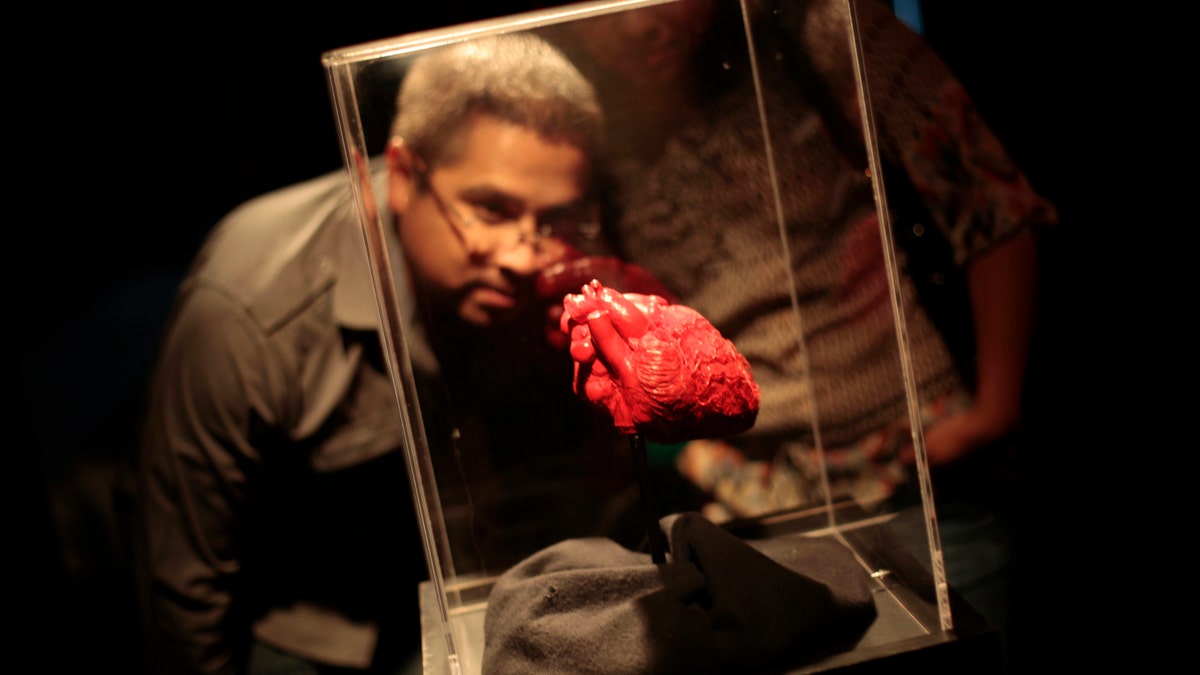
A man looks at a plastinated heart during the exhibition 'Body Worlds' by Gunther von Hagen at the Museo Miraflores in Guatemala City July 6, 2012. (REUTERS/Jorge Dan Lopez)
American doctors have developed two new wireless heart monitoring technologies that remotely measure the heart rate of cardiology patients, and may dramatically reduce their chances of sudden death from heart failure.
“This device is its own cellular platform,” says Dr. Rhea Pimental, a physician and electro-physiologist, at the University of Kansas hospital, which developed one of the two latest devices.
Heart failure impacts more than 5 million patients in the U.S., according to the American Heart Association. Hospital expenditures were $31 billion on heart failure therapy last year, according to St. Jude Hospital in Memphis, Tenn., whose doctors have also developed a remote heart monitor.
The heart monitoring devices have been in clinical trials, and are promising to be the next major step in telemedicine for the U.S. The prestigious St. Jude hospital recently secured approval from the federal Food and Drug Administration (FDA) for its version of the technology, and approval from Medicare for payment for patients to have the surgery to install the technology. The Kansas technology is still in the trial stage.
Surgically implanted, like a pacemaker, these miniature devices remotely transmit clinical data in real-time to physicians and nurses. Changes in medication can be made, like adding diuretics to a drug therapy, immediately, to maintain optimal arterial pressure in each patient, and pre-empt incidents of heart failure. Diuretics are drugs that promote the production, and elimination, of urine.
Clinical trials held for the St. Jude Medical foundation’s technology, CardioMEMS, reported that hospitalizations of patients for heart failure declined by 37 percent in 15 months, a hospital spokeswoman told FoxNews.com.
The new devices have the potential to replace the current technology, which records the heart rate of the patient while they are out of the doctor’s office, but must be downloaded on a medical device that can read the heart waves, called an electrocardiogram, in the doctor’s office.
For security, if a patient suffers chest pain or a fainting spell, the patient is provided with a hand held monitor, which they place over their heart and press "record" to send an instant transmission. This will give doctors information needed to determine if the patient should be rushed to the hospital, according to Medtronic, the Minneapolis-based developer which secured limited approval for the device earlier this year. With data security critically important in the health care industry, all transmissions from the devices are encrypted for an extra level of safety.
Before symptoms, signs show
“Many patients may not have symptoms during episodes of abnormal heart rhythm,” Dr. Guy Mayeda, cardiologist at Good Samaritan Hospital in Los Angeles, told FoxNews.com. “This new technology should allow earlier diagnosis and medical intervention in patients with intermittent heart rhythm disturbances, such as paroxysmal atrial fibrillation to hopefully prevent secondary complications such as embolic strokes.”
Atrial fibrillation, also known as ‘Afib,’ causes a rapid and disorganized heartbeat, and is the most prevalent form of cardiac arrhythmia, affecting nearly 2.7 million people in the U.S. The incidence of Afib increases with age and the number of cases is expected to increase significantly in the coming years as the population ages.
An embolic stroke is a blockage of a blood vessel in the brain, by an embolus, or a clot of blood.
Most physicians have never used these state-of-the-art IT tools, and have instead relied on imprecise measures, like a patient’s daily weight and blood pressure readings, to detect fluid buildup in the heart, and a possible, looming heart failure. These historical measures can take up to three weeks to show signs of potential heart failure.
These new sensors are small - typically just over half an inch long and a little over a tenth of an inch wide. They use micro-electromechanical systems (MEMS) technology to measure subtle changes in an artery's pressure, and are implanted in the heart through a leg vein during a minimally invasive procedure. Once implanted, the patient’s blood pressure and special nitinol (nonmagnetic nickel–titanium alloy) anchoring loops hold the sensor in place.
There are also devices that are non-medical grade which can be attached to one’s iPad or iPhone, as well as non-invasive devices, like the iRhythm, that use mathematical algorithms to analyze heart rates, experts told FoxNews.com“I have had patients send me EKGs [electrocardiograms, or recordings of the heart’s electrical activity] of their heartbeat by email in the middle of the night. In this way, the patient can keep themselves out of the hospital because I will be able to tell them that they're not having arrhythmia,” said Dr. Nicole Weinberg, cardiologist at Providence Saint John’s Health Center in Santa Monica, Calif.
Physicians are impressed by the two new technologies that are now emerging from clinical trials and receiving payment authorization from Medicare. These devices seem to be well ahead of previous technological developments for heart monitoring, doctors say.
“Previously, we would put monitors on patients for 24 hours and never see anything unusual. It is rare that a patient will have symptoms every 24 hours,” Dr. Weinberg told FoxNews.com.
“These tools help us to keep a monitor with a patient such that, if they have symptoms once a week, we will be able to catch it. Home monitoring is the ability for a medical professional to be able to get objective results about what's going on with the patient during the 99.9% of their life that they're not in the doctor's office.”








































